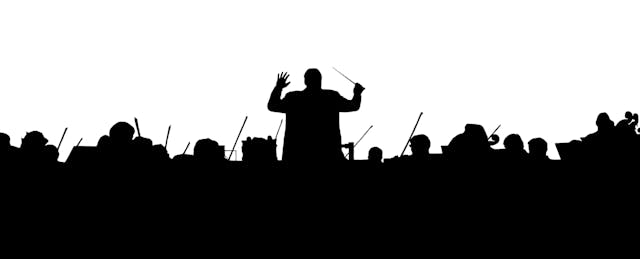I stood facing 47 middle school students. Their eyes were all on me and a hush fell over the gathered audience of families, teachers and community members. For the next eight seconds, they all had one job: wait for my hands to raise. After that, their tasks were vastly different.
Some played complex paradiddles on percussion instruments; some played delicate scale passages on woodwind instruments; others played bombastic fanfares on brass instruments.
We were putting on our spring band concert, the culmination of months of focused rehearsal. We had worked hard to present our best possible show and everyone was doing their part.
During my eight years as an instrumental music conductor for students in grades 4-8, differentiation—and in many cases individualization—were necessities. In 2017, I became a digital learning specialist for White Bear Lake Area Schools in a suburb of St. Paul, Minnesota, and in my new role, I’ve drawn heavily on what I learned from my experience conducting middle school orchestras.
These four lessons from my conducting years are guiding my current work with educators who are implementing personalized learning in their classrooms.
Learning Becomes Personal When Students Can Articulate Their Goals
As a middle school music teacher, my work began at the end of fourth grade when students selected their instruments. I saw fifth graders in large group rehearsals and small group sectionals and as they gained foundational skills, we began preparing for our first concert. My students expressed both excitement and fear when they were first introduced to the concert pieces. In those moments, collective, honest goal-setting was key because it prepared my students for the learning journey they’d take.
To generate meaningful goals, a student needs to understand who they are as a learner, where they are in a particular skill and where they want to go—but that can be difficult, especially for younger learners. Too often, we create goals for our students instead of with them. But the thing about setting goals is that if the learner can’t articulate them, they’re pointless.
A music teacher’s job is to corral the disparate goals of each student based on their instrument, experience, skill level and dedication to practice—and drive them incrementally forward. This isn’t very different than an academic teacher’s job—or at least it shouldn’t be.
I mimic these goal-setting practices in my new position. When I visit classrooms, I converse with students about the current lesson. If they can clearly convey the purpose of the material and accurately assess their progress—even if that means owning the fact that they’re still confused—then I consider the teacher to be successful. A student might not understand a new concept the day it’s introduced, but the teacher and student should know when additional practice or enrichment are needed.
Developing goals that learners understand deeply and can articulate independently helps maintain a sense of student accountability.
Use Performance to Create a Classroom Culture That Values Practice and Growth
In the world of instrumental music, performance is a given. Most music teachers and students are working towards a public performance. Public performances are often accompanied by anxiety, but they also offer a natural way to boost accountability because with a culminating performance, students are held accountable by their peers and the community.

Music teachers also use the concept of performance in less formal ways to assess growth. Progress is typically measured through “playing tests,” in which students rehearse specific skills and demonstrate their growth by playing them in person or through a recording. This type of assessment honors the value of practicing and improving upon what we already know by giving students space to practice skills they already possess—and that can transform a classroom.
Rather than sending a message like, “you received 10 out of 10, so now you can move on,” the message becomes, “you now possess a skill that you can apply to the next level of complexity in your performances.”
This shift in messaging can help teachers create a classroom culture where assessment is used to gauge each student’s readiness to build upon existing knowledge or to highlight the need for additional practice, rather than as a mark of success or shame.
Pacing Must Be Personalized
The idea that some people are “music people” can be toxic. Sure, some people are more interested in pursuing its study, and some people will stick with it in lieu of mastering other skills with their time—but everybody can learn music. And math. And poetry. And biology.
We just might not all learn these things at the same speed.
When implementing personalized learning in their classrooms, teachers often forget about this important truth. Creating an infrastructure that supports learners at various paces is critical for success—but it’s complicated because it’s not just the teacher that needs to believe this truth, it’s the students and families too.
It’s inevitable that some students will perceive themselves as musicians and others will not—but it’s important to recognize that self-image plays a large role in learning. Without confidence, it’s hard to muster up the dedication to practice and improve.
Music teachers naturally build enrichment exercises into each lesson for students who master new skills quickly. This practice helps to cultivate an environment where students seek out opportunities to learn more complicated music and showcase their skills.
A similar approach works for students who are learning at a slower progression. These students are often painfully aware of how their level of mastery compares to their peers, so it is important for the teacher to find ways to showcase strengths and to provide personalized support. Sometimes that means staying after school for extra help, pairing a student with a peer they trust or providing simpler exercises while fundamental skills are being developed.
I encourage the teachers I work with to use these tactics to tailor instruction and support. But the most important element of personalized pacing is an awareness, by both teacher and student, of exactly how they are progressing in class.
Passion And Pride Go A Long Way
Instrument selection was always the highlight of my year. Enthusiastic fourth graders blew into trumpet mouthpieces and matched rhythms on percussion in search of their perfect instrument. Students were eager to choose an instrument and, by extension, the entire scope and sequence of the skills they would learn through the next eight years of their musical careers.
There’s an incredible truth hidden in this process—students learn more when they are given a choice.
All of my students would be performing the same concert pieces, but they’d each be demonstrating their skills in a unique way. Witnessing students take pride in the skill they’ve gained on their chosen instrument is a special experience. Students aren’t just in band, they’re trumpeters and percussionists. It’s simultaneously collaborative and individualized—and that’s a rare gift.
Encouraging students to explore creative alternatives for how they demonstrate mastery like building a diorama, creating stop motion animations using Legos, or writing a graphic novel or song can yield astonishing results.
Music teachers trust that each student wants to demonstrate their musical skills through their performance on a chosen instrument. In the classroom, we can trust our students to demonstrate their knowledge through their chosen medium as well.
Many teachers assume that implementing personalized learning involves new software, a new learning management system or a fundamental shift in classroom design. But teachers can make learning personal by developing learning environments where students demonstrate what they know at their own pace through a medium that speaks to them.
When students are passionate, engaged and feel supported by their community of learners, they’ll pursue their work with enthusiasm and a sense of ownership—and they’ll thrive.


